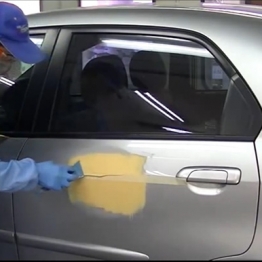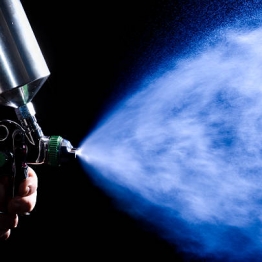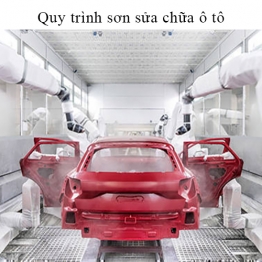Coatings used in automotive paint
1. Anti-rust paint (ED)
-
Purpose
The purpose of the anti-corrosion coating is to provide rust resistance and to help prevent corrosion and enhance adhesion between the substrate and subsequent coatings. Anti-rust paint is water-based, dry at 150oC - 180oC depending on the coating system.
-
ED composition
- Film-forming agent: As the main component of this coating, it can adhere to the surface of the material by electrostatic deposition. The main film-forming agent for this system is Epoxy resin and some other resins such as plastics. Melamine.
- Pigment: is intended to provide resistance to rust, turbidity, weathering and other properties of the film. Depending on the purpose of use, anti-rust is metal oxides such as: Fe2O3, Fe3O4, ..
- Solvent: The main solvent of ED is water, whose main purpose is to dissolve the film and disperse the pigment in the paint, allowing the film to form on the surface of the material and lose it. after the paint film completely dry.
- Additives are acids such as acetic acid, water-soluble amino acids and film-forming agents, which are responsible for creating better working and quality properties.
- DI water is an ionic water that removes excess paint, solvents and passivates the paint surface after the painting phase.
2. Primer
-
Purpose
Primers are used to smooth the surface with a primer, to protect the primer and to increase adhesion between the coatings.
-
Ingredient of primer
- Film-forming agents: Polyester film resins, Melanin resins, Epoxy resins and other plastics.
- Pigment: Including inorganic pigments such as zinc oxide (ZnO), titanium (TiO2), and other fillers such as CaCO3, BaSO4 ...
- Solvents: include aromatic solvents, freeze solvents, ethers and alcohol.
- Additives: including surface control agents, dispersants, anti-settling agents, ultraviolet absorbers.
3. Coating (Top coat)
a. Coating paint to be dried
Coating is the last coat intended for decorating as well as creating color, gloss, light contrast as well as some special properties and environmental tolerance, which is a dry paint system. High temperature 140oC for 18 minutes.
-
Solid coating
- Film-forming agents: Polyesters, Melamine resins, Alkyd resins and other resins.
- Pigments are inorganic oxides such as TiO2 and other pigments.
- Solvents: Solvents include aromatic solvents such as esters, ethers and alcohol.
- Additives: Surface control agents, anti-settling agents, dispersants, color stabilizers, ultraviolet absorbers, etc.
-
Metallic coating.
- Film-forming agents include acrylic resins, melamine resins, polyester resins, and other resins.
- Flour: is the color powder, in addition to other special pigments such as aluminum powder (Al), Mica scales and other pigments.
- Solvents: Solvents include aromatic solvents such as esters, ethers and alcohol.
- Additives: Surface control agents, anti-settling agents, dispersants, color stabilizers, ultraviolet absorbers, etc.
b. Self-drying paint
The purpose of self-drying paints is to be used to paint parts made of low temperature resistant material, subject to deformation, high temperature and repair. This coating system dries quickly at 80oC for 30 minutes or natural drying after 24 hours.
-
Solid coating
- Film-forming agents are plastics such as Alkyd, Acrylic, Nitro cellulose and other plastics.
- Pigments are inorganic oxides such as TiO2 and other pigments
- Solvents: Solvents include aromatic solvents such as esters, ethers and alcohol.
- Additives: Surface control agents, anti-settling agents, dispersants, color stabilizers, ultraviolet absorbers, etc.
-
Metallic coating
- Film-forming agents include plastics such as Acrylic, Alkyd, Polyurethane and other plastics.
- Flour: is the color powder, in addition to other special pigments such as aluminum powder (Al), Mica scales and other pigments.
- Solvents: Solvents include aromatic solvents such as esters, ethers and alcohol.
- Additives: Surface control agents, anti-settling agents, dispersants, color stabilizers, ultraviolet absorbers.
4. Coatings
a. The purpose of coating
Used to create an outer layer with a glossy finish and protect the interior paint from the environment.
b. Luster composition.
-
Drying oil
- Film-forming agent: Acrylic, Melanine, Polyester, Epoxy.
- Blooms: Do not use pigments
- Solvents: Solvents include aromatic solvents such as esters, ethers and alcohol.
- Additives: Surface control agents, ultraviolet absorbers and some other controlled substances.
-
Self-drying lacquer
- Film-forming agents: Acrylic resins, Alkyd resins, Nitro cellulose resins and other plastics.
- Blooms: do not use pigments
- Solvents: Solvents include aromatic solvents such as esters, ethers and alcohol.
- Additives: Surface control agents, ultraviolet absorbers and some other controlled substances.
Relative News







